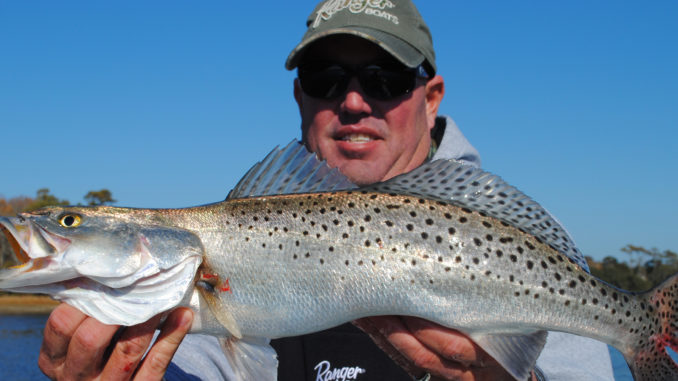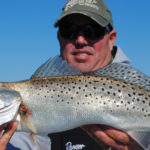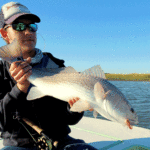
North of Myrtle Beach lies a cold-water jewel
Hot summer days, laying out on the beach, playing golf or stopping by one of the many roadside distractions — those are things that come to mind when Myrtle Beach is mentioned. But what many do not realize is that Myrtle Beach is also a great winter destination, especially if catching lots of redfish is what gets the blood pumping.
“What most perceive is not what is” said Capt. Mark Dickson of Shallow Minded Guide Service. “Once you get out on the water. there are no neon lights, tourists or tacky t-shirts like there are on land.”
Dickson, who operates out of Little River on the northern end of the Grand Strand, prefers to target shallow creeks that feed bigger water on low tide when the water is cold, searching for large schools of reds that congregate in pockets of deeper water, such as those found near sharp bends.
To get to these fish often requires longs trip up the shallow creeks. Dickson said: “When you start hitting the bottom, you’re halfway there!”
Redfish are easily located on the low tied, with several dozen or more of them in a single pool. Dickson tries to approach these areas stealthily as possible, but even if they are spooked, it only takes a few minutes for them to settle back down. Once found, the fishing — or in this case, the catching — is as good as it gets.
“Fifty- to 60-fish days are possible on a single tide, and it’s not unusual to catch seven or eight on as many consecutive casts,” he said.
Fishing creek mouths, ledges and docks on the Intercoastal Waterway earlier, before the water temperature drops too much, anglers catch redfish, trout and flounder, what Dickson calls an “inshore slam.”
Always a good choice when they are available, it’s hard to beat a live shrimp under a popping cork in early winter, especially for speckled trout. Artificial baits also work well, and Dickson uses a myriad of them, most of the time a scented bait like Gulp! on a Blue Water Candy jighead.
“I like to let the baits settle to the bottom before giving my cork a pop and making the bait spring up,” he said.
Water color dictates the choice of lure colors. In the winter, water is often stained to the color of iced tea, with around three feet of visibility, according to Dickson. In those conditions, he’ll use a bait in new penny on a brown, red or orange jighead. Heavy rains can muddy the waters and limit visibility.
“When the water is muddy, I use white or other lighter colors,” he said.
For inshore fishing, Dickson uses a 7-foot, medium-action Star spinning rod and Shimano 2500 Stradic reel spooled with 15- to 20-pound Power Pro braid. When targeting reds in the creeks, he fishes the bottom without a cork, using a 20-pound fluorocarbon leader attached to the braid with a Uni-Knot splice. If targeting trout under a cork he uses a 15-pound fluorocarbon leader.
“I prefer flourocarbon to mono, because it is denser and doesn’t float, and it is much more abrasion resistant,” he said. “Often, we are fishing near oyster beds that can easily cut mono but will only scrape fluoro, making for fewer lost fish and lures.”
Fly-fishing gear is also a great option, and one Dickson is seeing more and more anglers use it; he recommends 8-weight rods with intermediate lines and fluorocarbon leaders that can get a few feet quickly. Flies of choice are deep-water Clousers in red or chartreuse and white, and gold Spoon Flies. Saltwater fly-casting is challenging, much more so than what freshwater fly-fishing requires.
“Fifteen-knot winds are not uncommon here, and sometimes they are even higher, so being a proficient fly caster is very important,” he said.
Even on winter days that are relatively mild, a boat ride is often a chilling experience, but that does not mean dressing like an Eskimo is necessary. Dickson recommends wearing jeans, insulated socks and a few layers up top. Layering is a great way to stay warm, and it allows anglers to put on and take off to adjust to the conditions.
“Often, I start out with several layers on, but after poling the boat for a little while, I am quickly down to a single layer,” he said.
Simply put; once experienced, anglers are amazed at what Myrtle Beach has to offer them in the winter. Bald eagles and other wildlife are a common sight, solitude is abundant, and it is perhaps the best cold-weather inshore fishery in South Carolina.






Be the first to comment